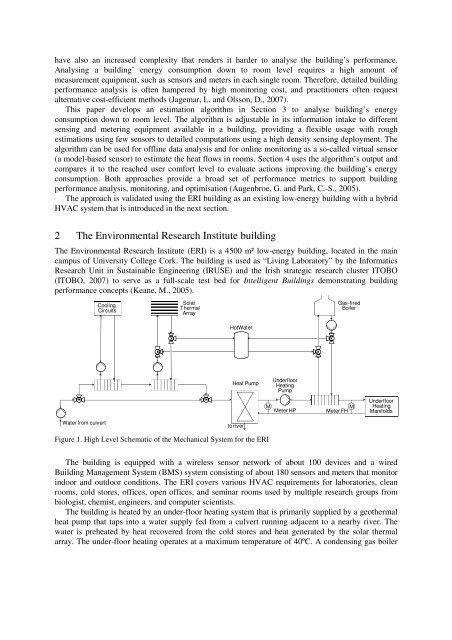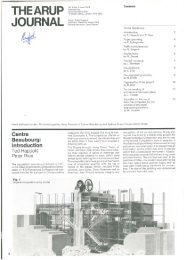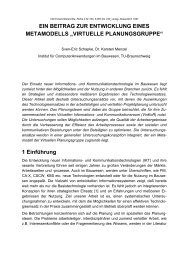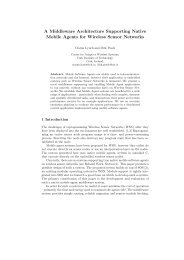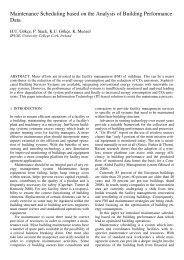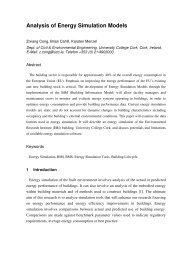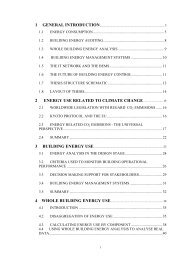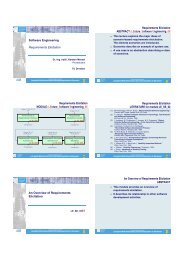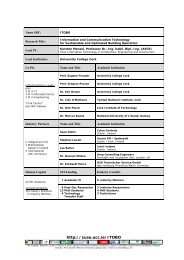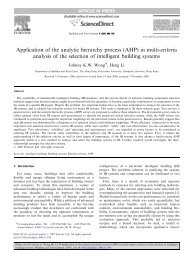Model-based virtual sensors for room heat metering and energy ...
Model-based virtual sensors for room heat metering and energy ...
Model-based virtual sensors for room heat metering and energy ...
You also want an ePaper? Increase the reach of your titles
YUMPU automatically turns print PDFs into web optimized ePapers that Google loves.
have also an increased complexity that renders it harder to analyse the building’s per<strong>for</strong>mance.Analysing a building’ <strong>energy</strong> consumption down to <strong>room</strong> level requires a high amount ofmeasurement equipment, such as <strong>sensors</strong> <strong>and</strong> meters in each single <strong>room</strong>. There<strong>for</strong>e, detailed buildingper<strong>for</strong>mance analysis is often hampered by high monitoring cost, <strong>and</strong> practitioners often requestalternative cost-efficient methods (Jagemar, L. <strong>and</strong> Olsson, D., 2007).This paper develops an estimation algorithm in Section 3 to analyse building’s <strong>energy</strong>consumption down to <strong>room</strong> level. The algorithm is adjustable in its in<strong>for</strong>mation intake to differentsensing <strong>and</strong> <strong>metering</strong> equipment available in a building, providing a flexible usage with roughestimations using few <strong>sensors</strong> to detailed computations using a high density sensing deployment. Thealgorithm can be used <strong>for</strong> offline data analysis <strong>and</strong> <strong>for</strong> online monitoring as a so-called <strong>virtual</strong> sensor(a model-<strong>based</strong> sensor) to estimate the <strong>heat</strong> flows in <strong>room</strong>s. Section 4 uses the algorithm’s output <strong>and</strong>compares it to the reached user com<strong>for</strong>t level to evaluate actions improving the building’s <strong>energy</strong>consumption. Both approaches provide a broad set of per<strong>for</strong>mance metrics to support buildingper<strong>for</strong>mance analysis, monitoring, <strong>and</strong> optimisation (Augenbroe, G. <strong>and</strong> Park, C.-S., 2005).The approach is validated using the ERI building as an existing low-<strong>energy</strong> building with a hybridHVAC system that is introduced in the next section.2 The Environmental Research Institute buildingThe Environmental Research Institute (ERI) is a 4500 m² low-<strong>energy</strong> building, located in the maincampus of University College Cork. The building is used as “Living Laboratory” by the In<strong>for</strong>maticsResearch Unit in Sustainable Engineering (IRUSE) <strong>and</strong> the Irish strategic research cluster ITOBO(ITOBO, 2007) to serve as a full-scale test bed <strong>for</strong> Intelligent Buildings demonstrating buildingper<strong>for</strong>mance concepts (Keane, M., 2005).CoolingCircuits P-12SolarThermalArrayHotWaterGas-firedBoilerHeat PumpUnderfloorHeatingPumpP-7MMeter HPMeter FH MUnderfloorHeatingManifoldsWater from culverttoriverFigure 1. High Level Schematic of the Mechanical System <strong>for</strong> the ERIThe building is equipped with a wireless sensor network of about 100 devices <strong>and</strong> a wiredBuilding Management System (BMS) system consisting of about 180 <strong>sensors</strong> <strong>and</strong> meters that monitorindoor <strong>and</strong> outdoor conditions. The ERI covers various HVAC requirements <strong>for</strong> laboratories, clean<strong>room</strong>s, cold stores, offices, open offices, <strong>and</strong> seminar <strong>room</strong>s used by multiple research groups frombiologist, chemist, engineers, <strong>and</strong> computer scientists.The building is <strong>heat</strong>ed by an under-floor <strong>heat</strong>ing system that is primarily supplied by a geothermal<strong>heat</strong> pump that taps into a water supply fed from a culvert running adjacent to a nearby river. Thewater is pre<strong>heat</strong>ed by <strong>heat</strong> recovered from the cold stores <strong>and</strong> <strong>heat</strong> generated by the solar thermalarray. The under-floor <strong>heat</strong>ing operates at a maximum temperature of 40ºC. A condensing gas boiler


